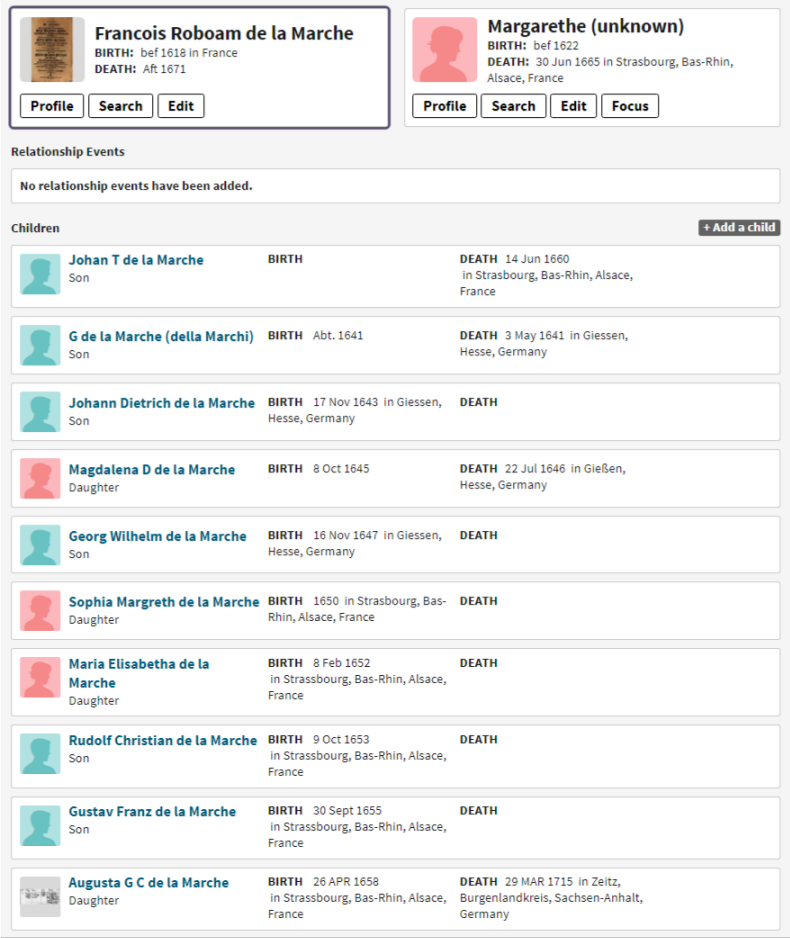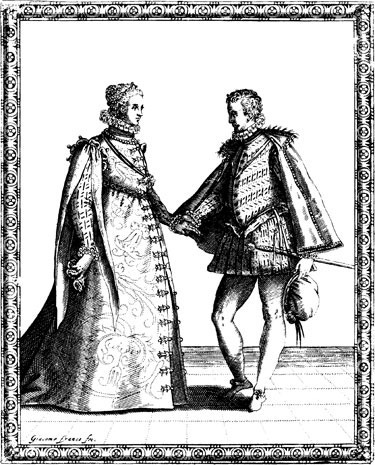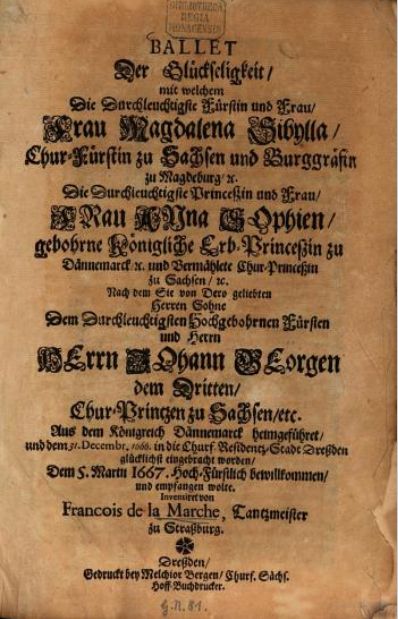In 2015 I wrote about my search for Augusta Gustave Catharina de la Marche, my 7th great-grandmother. She was born is Strasbourg, Bas-Rhin, on 26 April 1658. When I finally located the original baptism record through the online holdings of Les Archives Départementales du Bas-Rhin, it named her father as Franz de la Marche, dance master.
I received some help with translation from an individual who is part of the Alsace Genealogy Facebook group; he also provided links to some biographical data. The most extensive bio came from Das Bayerische Musiker-Lexikon Online (BMLO). Franz de la Marche, it was said, was born in Munich and held a doctorate of theology from the College in Rome. From Rome he was appointed the spiritual advisor to the Prince Bishop of Eichstädt and he was also Kapellmeister there. (Kapellmeister is the leader of a church orchestra.) The last post that he held before his death between 1662 and 1672 was as “zweiten Kanonikus” (second canon) for the Willibald choir. He was also a composer having written Musikalisches Jägerhorn, in deutschen Arien. Yet, another brief biographical entry indicated that Franz de la Marche was tanzmeister (dance master) in the employ of the Prince of Hesse-Darmstadt.
Franz de la Marche certainly was gifted. All of this talent and the man could dance, too?
I began to have misgivings. Catharina de la Marche was baptized Lutheran. How did a man, who was the Spiritual counselor of a Roman Catholic prince bishop, come to baptize his children Lutheran? Was a man who was serious about arranging sacred music for the church likely to be dancing as well. The entertainment aspect of dance seemed a little frivolous by comparison.
After a great deal of searching, using French and German search engines, I found an answer in a scholarly article on Baroque dance. According to author Giles Bennett (“Tanz am Braunschweiger Hof um 1700“; Rothenfelser Tanzsymposion, June 2004), there were two Franz de la Maches who were contemporaries. The dancing master and the Kapellmeister were, indeed, two different people. I heaved a sigh of relief. I narrowly averted confusing the two men as one.
So who was the Franz de la Marche, the dancing master? His given name is often seen as François, the French version of Franz. He did spend much of his career serving Prince Georg II, Landgrave of Hesse-Darmstadt, and was the first dance master for his court. And, what services did a dance master provide to his royal patrons? The job is well-described by the blog of the California Ballet:
With dance being such an important part of court interactions, most nobles employed a specialized instructor, a Dance Master, to give them daily instruction in court dance. These Dance Masters were considered experts on proper social behavior, and would instruct the Nobles on such things as how to dress properly, how to bow correctly, how to handle one’s gloves, fans, or swords with ease, how to properly carry oneself. These things were all requisites for advancement within the courtly circles, and a single fumble could set a nobleman or noblewoman back years in their advancement. This attention to personal deportment may still be seen in ballet dancers today – how they stand, walk, carry themselves in a lifted position.(Retrieved from California Ballet; https://californiaballet.wordpress.com/2010/05/17/ May 17, 2010).
Sometime prior to 1649, Franz requested a letter of recommendation from the Landgrave supporting his application to establish residency in Strasbourg. This letter is catalogued as being held in the collection of Les Archives Départementales du Bas-Rhin (Lettre de recommandation délivrée par le landgrave George au maître de danse François de la Marche, qui désire s’établir à Strasbourg), but it has not been digitized. In 1658 François de la Marche is known to have choreographed a major ballet called Die Tugend-kette (Histoire du spectacle en Europe (1580-1750) Béhar, Pierre & Watanabe-O’Kelly, Helen; Harrassowitz Verlag, 1999; p. 554).
Franz de la Marche was, it turns out, part of a “dancing dynasty.” In her book, “The Pre-Romantic Ballet” (Dance Horizons, 1975), Marian Hannah Winter says that the de la Marche family was probably the greatest dancing family in Germany during the 17th century. She speculates that they may have been descendants of Olivier de la Marche, (1426-1501), chronicler and poet, born at the Chateau de la Marche, in Franche-Comté. I have no evidence any relationship, but one does wonder how one family rose to such prominence for the art of dancing.
Giles Bennett mentions Ulrich Roboam de la Marche and Friedrich de la Marche in Wolfenbüttel. The activity of Franz de la Marche seems to die out in Strasbourg and Darmstadt in the late 1650’s; but around 1670, he is seen again in Bayreuth and Dresden. He is probably the individual called François de la Marche, le Pere (the father); associated with him are François, Jacob, Ludwig, (Johann) Dietrich, Georg (Wilhelm) and Rudolf Christian de la Marche.
It is interesting to note that the prominent dancing masters often worked in collaboration, and the de la Marches were no exception. A typical example of a production that saw the active involvement of dancing masters from more than one court is the Kurtzes Ballet vom Sieg der Liebe (Short Ballet on the Victory of Love), performed in Stuttgart in 1671 to celebrate the marriage of Margrave Christian Ernst of Brandenburg-Bayreuth to Sophia Louisa of Württemberg-Stuttgart. Among the performers were François Maran, dancing master at the Bayreuth court, and his colleague Marin Sanry, who held the equivalent position in Stuttgart. Both men certainly also choreographed sections of the production. Subsequently, following the arrival of Sophia Louisa at her new court in Bayreuth, a second ballet was given, the Sudetische Frülings-Lust (Pleasures of the Sudeten Spring). The libretto’s title page proclaims Maran’s role as the entertainment’s ‘inventor’ and lists among those dancing alongside him: Sanry from Stuttgart; François de la Marche, the court dancing master at Darmstadt; the latter’s son, also François; and Rudolph de la Marche, a dancing master from Dresden. (“Collaborative Creative Thought and Practice in Music”; Barrett, Margaret S., editor; Ashgate Publishing, Ltd.; 2014; p. 145).
François de la Marche also wrote his own ballets. One that has survived in print form is Ballet der Glückseligkeit (Bergen, 1667), which translates as ballet of bliss.
Although I started my research in Strasbourg, I knew that the dance master had older children that must have been born elsewhere. I checked the record for the city of Darmstadt, but found none. Eventually, I was led to Giessen based on a reference from Ernst Pasquein in “Geschichte der Musik und des Theaters am Hofe zu Darmstadt, Vol 1” (Wittich, 1853, pg. 27). This sourse indicated that Hessen Landgrave Georg II hired François de la Marche as a dance teacher for his children and paid 172 Gld. for his move from Paris to Giessen in 1638. Four children were born in Giessen: a son (Georg or Wilhelm – the records conflict) who was born in 1641 and died a few months later in May; Johann Dietrich, born 17 November 1643; Magdalena Dorothea, born 8 October 1645 and died 22 July 1646; and Georg Wilhelm, born 16 November 1747.
Children who were born in Strasbourg were: Johan Theodoricus (died 1660); Sophia Margreth (born 1650); Maria Elisabetha (born 1652); Rudolph Christian (born 1653); Gustav Franz (born 1655); and, Augusta Gustave Catharina, my 7th great-grandmother (born 1658). All of the de la Marche children born in Geissen and Strasbourg had godparents of noble standing.
Margarethe is the only mother mentioned in the records, but her maiden name is never given. I have not found a marriage record in Giessen, so I expect she and the dance master were married earlier. The possibility of even older children lingers. Margarethe’s death is recorded in St. Thomas Parish in Strasbourg as 30 June 1665. It appears that Franz de la Marche remarried. A record from St.Thomas Parish for 1668 (v 250, p 66) translates to say “by permission of the Council and XXI on the 14th of January Herr François de la Marche the Danzmeister married Jgfr. (Jungfrau) Judith Barbanoier, daughter of Matthias Barbanoier the Wollenweber (weaver of woolens) from Markirch” (Translation by Alex Bueno-Edwards). Since the younger Gustav Franz was only 13, this was almost certainly the father.
Franz de la Marche lived in Strasbourg for well over a decade. The family that I have been able to attribute to him are shown in an updated family group sheet:
 Family Group Sheet for François de la Marche
Family Group Sheet for François de la Marche
I have made some progress sorting through the names of the dancing de la Marches. Sons Johann Dietrich and Georg Wilhelm definitely danced. Also, there are some reference to “a son of the same name” dancing with the father – that could be Gustav Franz. The son Rudolph Christian, who was born in 1653, seems to be too young to be the aforementioned dancing master for the Dresden court. Perhaps this was a brother of Franz. Sophia Margreth, daughter of Franz, married François Maran, her father’s colleague and dancing master at the court in Bayreuth.
The connection to François Maran brings up another consideration. François Maran was the son of Jean Maran of Stockholm, Sweden. It has been suggested that the Marans may have been Walloons. François de la Marche was certainly a Lutheran. Ulrich Roboam de la Marche was a confirmed Calvanist and a Huguenot. The common denominator is that they were all French Protestants. Keep in mind that Augusta Gustave Catharina de la Marche married the Pfarrer of Zeitz and 2nd great-grandson of Martin Luther. Incidentally, a daughter of Ulrich Roboam de la Marche also married in Zeitz.
This is my amateur attempt to connect the de la Marches who comprised a dancing dynasty. Scholars who study Baroque dance don’t seem to have made as much progress in connecting the families as I have, but I will confess that I still have a lot of work to do.


There is at least one other child of Franz de la Marche and Margaretha. Her name was Sophia Margaretha. She was born 1650, and baptized on XXI Trinity (not sure which date that translates to, but it’s probably late October/early November). (Birth #142, St. Thomas parish, Image 93/233, http://archives.bas-rhin.fr/detail-document/ETAT-CIVIL-C478-P87-R292709#visio/page:ETAT-CIVIL-C478-P87-R292709-3280117)
I also found Margaretha’s death record in the St. Thomas parish records, Image 224/233. If I’m reading the record correctly, she died 30 Jun 1665 (http://archives.bas-rhin.fr/detail-document/ETAT-CIVIL-C478-P87-R292709#visio/page:ETAT-CIVIL-C478-P87-R292709-3280248). Therefore, it is confirmed that Margaretha died in Strausbourg.
Debbie,
Thank you! I had since found the death of Margaretha, but NOT the baptism for Sophia Margaretha. I have located quite a bit of new information since I wrote this post over two years ago. I discovered the marriage of Sophia Margaretha to Francois Maran in Darmstadt on 19 Oct 1668, but I somehow missed her baptism record. This record referred to her father as Francois Roboam de la Marche and identified him as dance master.
I also learned that there were older children of Francois and Margaretha de la Marche who were born in Giessen, Hesse. These four children were:
G de la Marche (della Marchi), son, BIRTH Abt. 1641
DEATH 3 May 1641 in Giessen, Hesse, Germany
Johann Dietrich de la Marche, son, BIRTH 17 Nov 1643 in Giessen, Hesse, Germany
Magdalena de la Marche, daughter, BIRTH 8 Oct 1645
DEATH 22 Jul 1646 in Giessen, Hesse, Germany
Georg Wilhelm de la Marche, son, BIRTH 16 Nov 1647 in Giessen, Hesse, Germany
I would love to find out exactly who Margaretha was. What was her surname and where was she born? New information documents that Georg II Landgrave of Hesse paid the travel expenses to move Francois de la Marche from Paris to Geissen, but that does not guarantee that he was born there. He could have been educated there or been working there. I still have a lot of unanswered questions. I especially would like to know if Ulrich Roboam de la Marche, dance master at Worlfenbüttel, was a son. If so, where was he born?
Thanks again for your help!
Hello, I found out that I have ancestry from someone called Augusta Margarethe Sophia de la Marche, who died 1749 in Kiel. I wonder if we might have common ancestry (altough far back)?
The link to my ancestry line is here (my great great grandmother was named Gravenhorst, she was born 1795):
https://www.ronlev.dk/bibliotek/1274.pdf